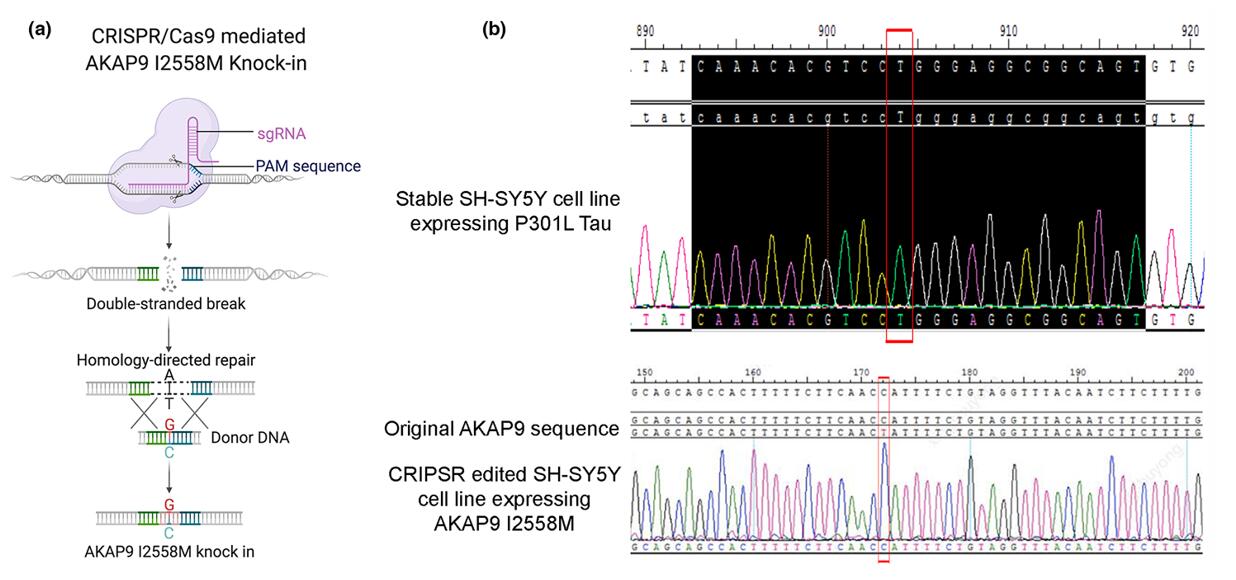Cas9 Stable Cell Line - SH-SY5Y
Cat.No. : CSC-RO0181 Host Cell: SH-SY5Y
Size: >1x10^6 cells/vial Validation: T7 Endonuclease I assay
Cat.No. : CSC-RO0181 Host Cell: SH-SY5Y
Size: >1x10^6 cells/vial Validation: T7 Endonuclease I assay
| Cat. No. | CSC-RO0181 |
| Product Type | Cas9 overexpression stable cell line |
| Introduction | Clustered regularly interspaced palindromic repeats (CRISPR)/Cas9 is a gene-editing technology that contains two essential components: a guide RNA (gRNA) to match a target gene, and the Cas9 (CRISPR-associated protein 9) endonuclease which causes a double-stranded DNA break, allowing modifications to the genome via nonhomologous end joining (NHEJ) or homology-directed repair (HDR). |
| Cell Line Information | SH-SY5Y-Cas9 cell line is engineered to stably overexpress Cas9 nuclease. The Cas9 nuclease in SH-SY5Y-Cas9 cell line has been functionally validated using T7 Endonuclease I assay. In combination with separately transfected sgRNAs, SH-SY5Y-Cas9 cell line can be used to efficiently generate targeted genomic modifications including gene knockout, gene knockin, gene mutagenesis, gene tagging etc. It is also an ideal cell line model for sgRNA screening and validation, either individually or in pools. |
| Target Gene | Cas9 |
| Host Cell | SH-SY5Y |
| Applications | 1) CRISPR genome editing, such as gene knockout (KO), gene knockin (KI), gene mutagenesis, gene tagging etc. 2) High-throughput sgRNA screening and validation |
| Quality Control | 1) T7E1 assay 2) Mycoplasma detection |
| Size Form | One vial of frozen cells, typically >1x10^6 cells/vial |
| Shipping | Dry ice |
| Storage | Liquid nitrogen |
| Species | Homo sapiens (Human) |
| Mycoplasma | Negative |
| Format | One frozen vial containing millions of cells |
| Storage | Liquid nitrogen |
| Safety Considerations |
The following safety precautions should be observed. 1. Use pipette aids to prevent ingestion and keep aerosols down to a minimum. 2. No eating, drinking or smoking while handling the stable line. 3. Wash hands after handling the stable line and before leaving the lab. 4. Decontaminate work surface with disinfectant or 70% ethanol before and after working with stable cells. 5. All waste should be considered hazardous. 6. Dispose of all liquid waste after each experiment and treat with bleach. |
| Ship | Dry ice |
Researchers employed CRISPR‐Cas9 technology to investigate the impact of a rare mutation (rs144662445) in the AKAP9 gene, linked to Alzheimer's disease (AD) in African Americans (AA), on tau pathology and the tau interactome in SH‐SY5Y P301L neuron‐like cells. The mutation notably elevated phosphorylated tau levels, particularly at Ser396/Ser404. Additionally, analysis of the tau interactome revealed dysregulation of RNA translation, localization, and oxidative activity, resembling findings from human AD brain samples. Functional assays confirmed reduced protein synthesis and increased oxidative stress, mimicking AD pathology. These findings highlight the role of AKAP9 in AD pathogenesis.
 Figure 1. CRISPR-mediated AKAP9 I2558M mutation knock-in was performed in SH-SY5Y P301L cells, followed by neuronal differentiation. Mutation generation was confirmed by Sanger sequencing. (You Y, et al., 2022)
Figure 1. CRISPR-mediated AKAP9 I2558M mutation knock-in was performed in SH-SY5Y P301L cells, followed by neuronal differentiation. Mutation generation was confirmed by Sanger sequencing. (You Y, et al., 2022)
Creative Biogene's Cas9 Stable Cell Line-SH-SY5Y expedites similar studies, eliminating the need for gene editing steps. This pre-engineered cell line directly investigates gene mutation effects on tau pathology and the tau interactome, saving time and costs while accelerating disease mechanism understanding.

Our promise to you:
Guaranteed product quality, expert customer support.
 24x7 CUSTOMER SERVICE
24x7 CUSTOMER SERVICE
 CONTACT US TO ORDER
CONTACT US TO ORDER